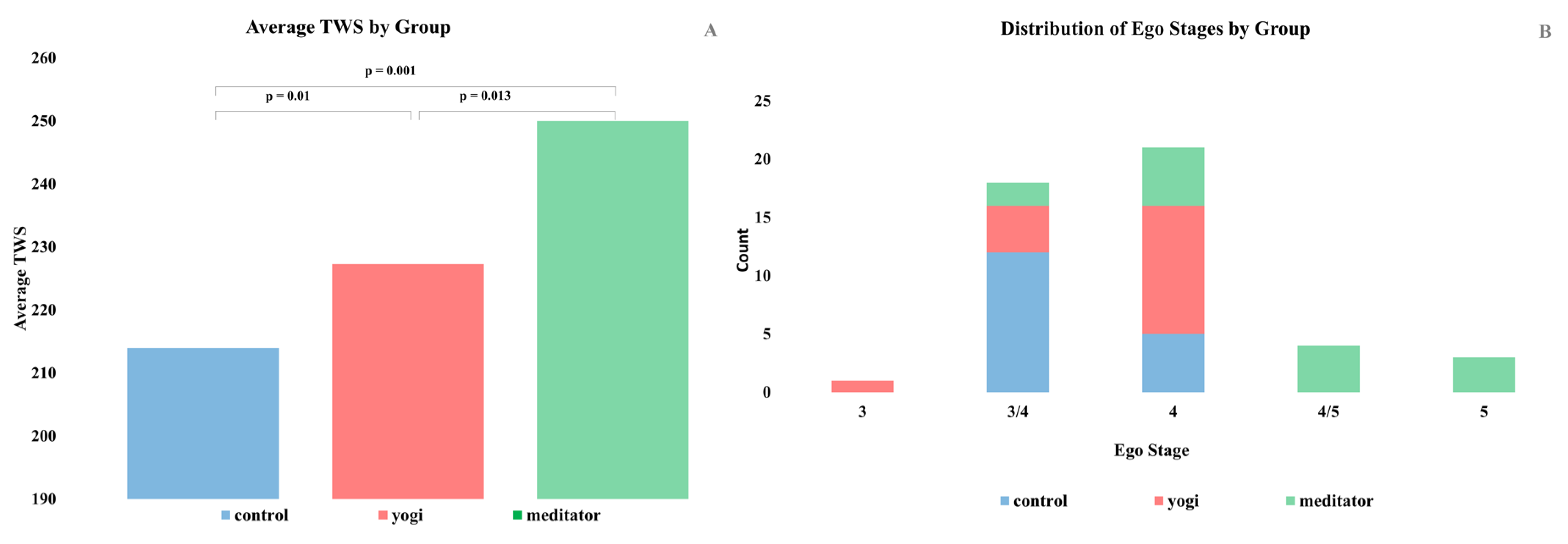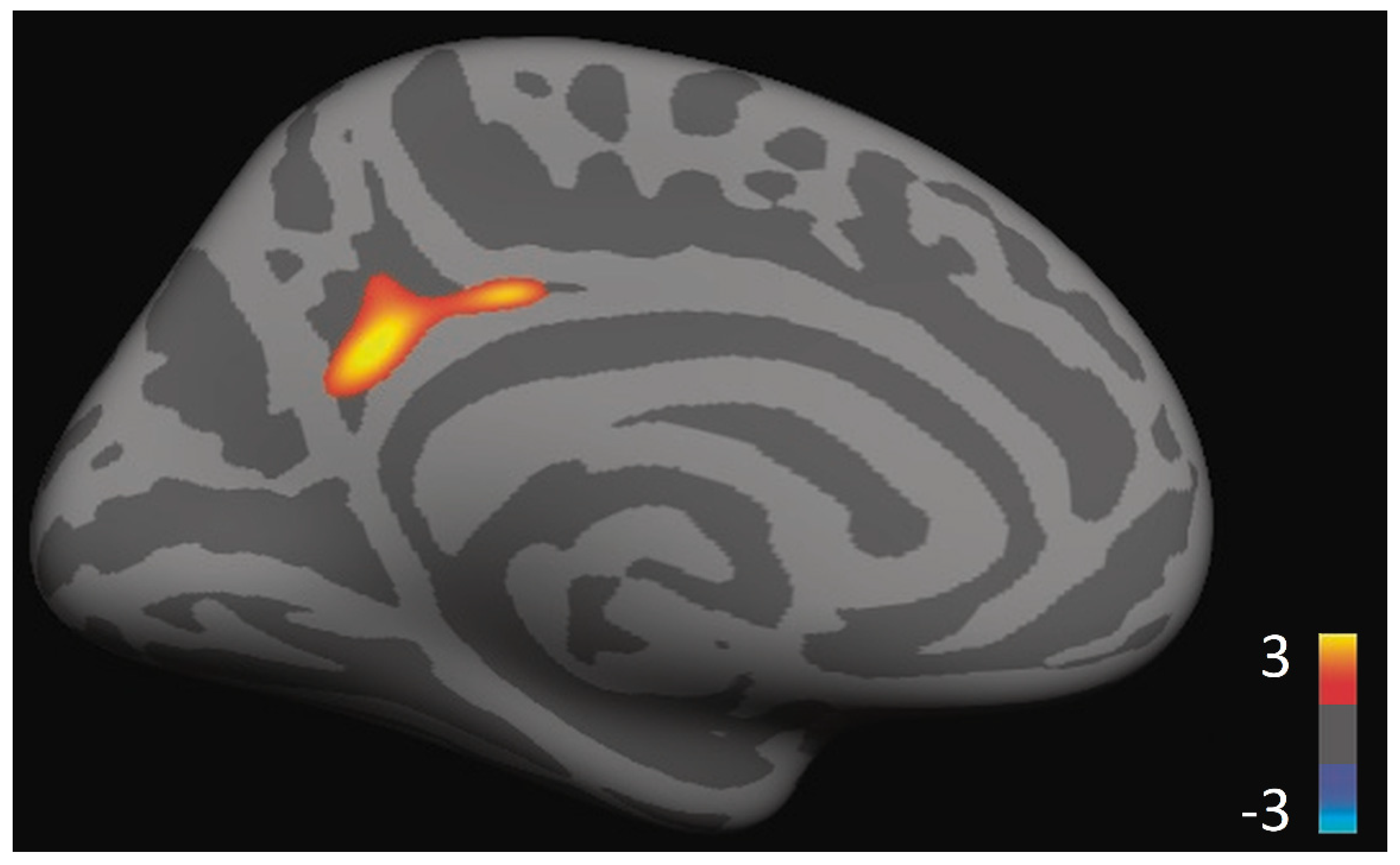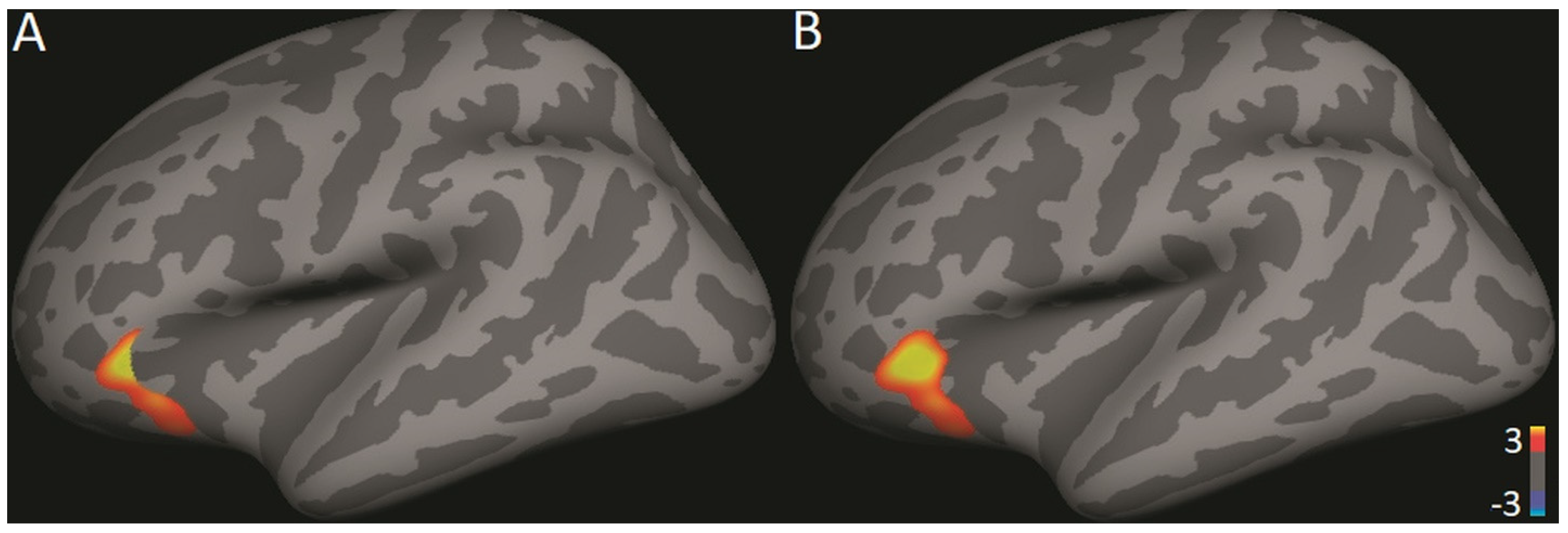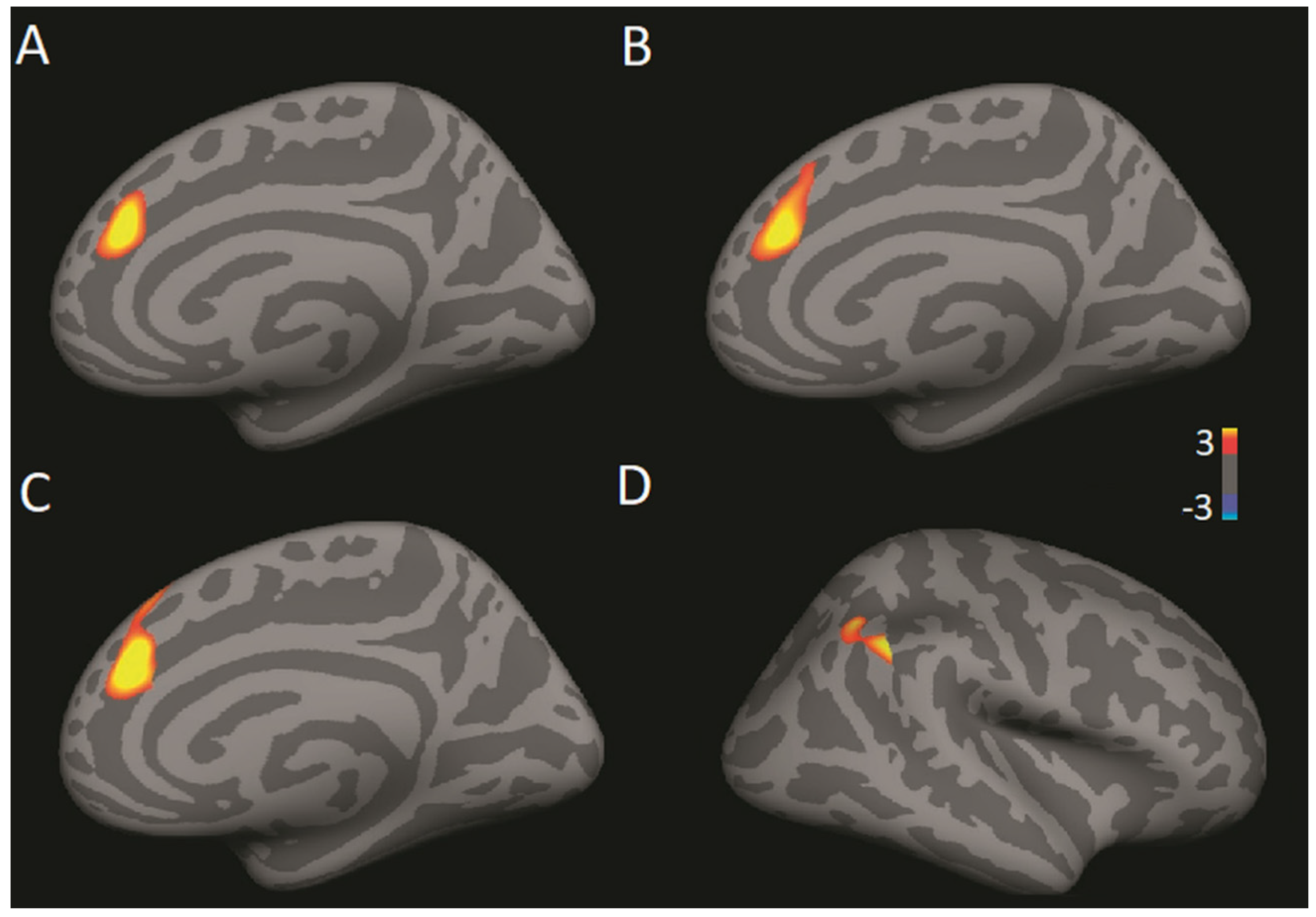Brain Structure and Functional Connectivity Correlate with Psychosocial Development in Contemplative Practitioners and Controls
Abstract
1. Introduction
2. Materials and Methods
2.1. Ego Development
2.2. Cognitive and Self-Report Measures
2.3. Amount of Practice
2.4. Statistical Analysis
2.5. Neuroimaging
3. Results
4. Discussion
Author Contributions
Funding
Institutional Review Board Statement
Informed Consent Statement
Data Availability Statement
Acknowledgments
Conflicts of Interest
References
- Loevinger, J. The Meaning and Measurement of Ego Development. Am. Psychol. 1966, 21, 195. [Google Scholar] [CrossRef]
- Cook-Greuter, S.R. Postautonomous Ego Development: A Study of Its Nature and Measurement. Ph.D. Dissertation, ProQuest Information & Learning, Ann Arbor, MI, USA, 1999. [Google Scholar]
- Cook-Greuter, S.R. Mature Ego Development: A Gateway to Ego Transcendence? J. Adult Dev. 2000, 7, 227–240. [Google Scholar] [CrossRef]
- Cook-Greuter, S.R. Nine Levels of Increasing Embrace in Ego Development: A Full-Spectrum Theory of Vertical Growth and Meaning Making. Zugriff am 2013, 18, 2015. [Google Scholar]
- Cohn, L.D.; Westenberg, P.M. Intelligence and Maturity: Meta-Analytic Evidence for the Incremental and Discriminant Validity of Loevinger’s Measure of Ego Development. J. Pers. Soc. Psychol. 2004, 86, 760–772. [Google Scholar] [CrossRef] [PubMed]
- Gilmore, J.M.; Durkin, K. A Critical Review of the Validity of Ego Development Theory and Its Measurement. J. Pers. Assess. 2001, 77, 541–567. [Google Scholar] [CrossRef] [PubMed]
- Hauser, S.T. Loevinger’s Model and Measure of Ego Development: A Critical Review. Psychol. Bull. 1976, 83, 928. [Google Scholar] [CrossRef]
- Hauser, S.T. Loevinger’s Model and Leasure of Ego Development: A Critical Review, II. Psychol. Inq. 1993, 4, 23–30. [Google Scholar] [CrossRef]
- Novy, D.M. An Investigation of the Progressive Sequence of Ego Development Levels. J. Clin. Psychol. 1993, 49, 332–338. [Google Scholar] [CrossRef]
- Novy, D.M.; Frankiewicz, R.G.; Francis, D.J.; Liberman, D.; Overall, J.E.; Vincent, K.R. An Investigation of the Structural Validity of Loevinger’s Model and Measure of Ego Development. J. Pers. 1994, 62, 87–118. [Google Scholar] [CrossRef]
- Westenberg, P.M.; Gjerde, P.F. Ego Development during the Transition from Adolescence to Young Adulthood: A 9-Year Longitudinal Study. J. Res. Personal. 1999, 33, 233–252. [Google Scholar] [CrossRef]
- Helson, R.; Roberts, B.W. Ego Development and Personality Change in Adulthood. J. Pers. Soc. Psychol. 1994, 66, 911. [Google Scholar] [CrossRef]
- Loevinger, J. Objective Tests as Instruments of Psychological Theory: Monograph Supplement 9. Psychol. Rep. 1957, 3, 635–694. [Google Scholar] [CrossRef]
- Loevinger, J. Construct Validity of the Sentence Completion Test of Ego Development. Appl. Psychol. Meas. 1979, 3, 281–311. [Google Scholar] [CrossRef]
- Lilgendahl, J.P.; Helson, R.; John, O.P. Does Ego Development Increase during Midlife? The Effects of Openness and Accommodative Processing of Difficult Events. J. Pers. 2013, 81, 403–416. [Google Scholar] [CrossRef]
- McCrae, R.R.; Costa, P.T. Openness to Experience and Ego Level in Loevinger’s Sentence Completion Test: Dispositional Contributions to Developmental Models of Personality. J. Pers. Soc. Psychol. 1980, 39, 1179–1190. [Google Scholar] [CrossRef]
- Staudinger, U.M.; Lopez, D.F.; Baltes, P.B. The Psychometric Location of Wisdom-Related Performance: Intelligence, Personality, and More? Pers. Soc. Psychol. Bull. 1997, 23, 1200–1214. [Google Scholar] [CrossRef]
- Starrett, R.H. The Conceptual Commonality between Impulsiveness as a Personality Trait and as an Ego Development Stage. Personal. Individ. Differ. 1983, 4, 265–274. [Google Scholar] [CrossRef]
- Helson, R.; Wink, P. Two Conceptions of Maturity Examined in the Findings of a Longitudinal Study. J. Pers. Soc. Psychol. 1987, 53, 531. [Google Scholar] [CrossRef] [PubMed]
- Browning, D.L. Aspects of Authoritarian Attitudes in Ego Development. J. Pers. Soc. Psychol. 1983, 45, 137. [Google Scholar] [CrossRef]
- Newman, D.L.; Tellegen, A.; Bouchard, T.J., Jr. Individual Differences in Adult Ego Development: Sources of Influence in Twins Reared Apart. J. Pers. Soc. Psychol. 1998, 74, 985. [Google Scholar] [CrossRef]
- Lanning, K.; Pauletti, R.E.; King, L.A.; McAdams, D.P. Personality Development through Natural Language. Nat. Hum. Behav. 2018, 2, 327–334. [Google Scholar] [CrossRef]
- Walsh, R. The Transpersonal Movement: A History and State of the Art. J. Transpers. Psychol. 1993, 25, 123–139. [Google Scholar]
- Meditation: Classic and Contemporary Perspectives; Shapiro, D.H., Walsh, R.N., Eds.; AldineTransaction: Piscataway, NJ, USA, 1984. [Google Scholar]
- Chandler, H.M.; Alexander, C.N.; Heaton, D.P.; Grant, J. A 10–Year Longitudinal Study of Self Development through the Transcendental Meditation Program. J. Soc. Behav. Personal. 2005, 17, 93–122. [Google Scholar]
- Gard, T.; Taquet, M.; Dixit, R.; Hölzel, B.K.; de Montjoye, Y.A.; Brach, N.; Salat, D.H.; Dickerson, B.C.; Gray, J.R.; Lazar, S.W. Fluid Intelligence and Brain Functional Organization in Aging Yoga and Meditation Practitioners. Front. Aging Neurosci. 2014, 6, 76. [Google Scholar] [CrossRef] [PubMed]
- Gard, T.; Taquet, M.; Dixit, R.; Hölzel, B.K.; Dickerson, B.C.; Lazar, S.W. Greater Widespread Functional Connectivity of the Caudate in Older Adults Who Practice Kripalu Yoga and Vipassana Meditation than in Controls. Front. Hum. Neurosci. 2015, 9, 9. [Google Scholar] [CrossRef] [PubMed]
- Axelrod, V.; Rees, G.; Bar, M. The Default Network and the Combination of Cognitive Processes That Mediate Self-Generated Thought. Nat. Hum. Behav. 2017, 1, 896–910. [Google Scholar] [CrossRef]
- Meyer, M.L.; Lieberman, M.D. Why People Are Always Thinking about Themselves: Medial Prefrontal Cortex Activity during Rest Primes Self-Referential Processing. J. Cogn. Neurosci. 2018, 30, 714–721. [Google Scholar] [CrossRef]
- Huang, Z.; Obara, N.; Davis IV, H.H.; Pokorny, J.; Northoff, G. The Temporal Structure of Resting-State Brain Activity in the Medial Prefrontal Cortex Predicts Self-Consciousness. Neuropsychologia 2016, 82, 161–170. [Google Scholar] [CrossRef]
- Kucyi, A.; Davis, K.D. Dynamic Functional Connectivity of the Default Mode Network Tracks Daydreaming. Neuroimage 2014, 100, 471–480. [Google Scholar] [CrossRef]
- Mason, R.A.; Just, M.A. The Role of the Theory-of-Mind Cortical Network in the Comprehension of Narratives. Linguist. Lang. Compass 2009, 3, 157–174. [Google Scholar] [CrossRef]
- Poerio, G.L.; Sormaz, M.; Wang, H.T.; Margulies, D.; Jefferies, E.; Smallwood, J. The Role of the Default Mode Network in Component Processes Underlying the Wandering Mind. Soc. Cogn. Affect. Neurosci. 2017, 12, 1047–1062. [Google Scholar] [CrossRef]
- Fox, K.C.; Spreng, R.N.; Ellamil, M.; Andrews-Hanna, J.R.; Christoff, K. The Wandering Brain: Meta-Analysis of Functional Neuroimaging Studies of Mind-Wandering and Related Spontaneous Thought Processes. Neuroimage 2015, 111, 611–621. [Google Scholar] [CrossRef] [PubMed]
- Spreng, R.N.; Mar, R.A.; Kim, A.S.N. The Common Neural Basis of Autobiographical Memory, Prospection, Navigation, Theory of Mind, and the Default Mode: A Quantitative Meta-Analysis. J. Cogn. Neurosci. 2009, 21, 489–510. [Google Scholar] [CrossRef] [PubMed]
- Stawarczyk, D.; Jeunehomme, O.; D’Argembeau, A. Differential Contributions of Default and Dorsal Attention Networks to Remembering Thoughts and External Stimuli From Real-Life Events. Cereb. Cortex 2017, 28, 4023–4035. [Google Scholar] [CrossRef] [PubMed]
- Tomasi, D.; Volkow, N.D. Network Connectivity Predicts Language Processing in Healthy Adults. Hum. Brain Mapp. 2020, 41, 3696–3708. [Google Scholar] [CrossRef]
- Broyd, S.J.; Demanuele, C.; Debener, S.; Helps, S.K.; James, C.J.; Sonuga-Barke, E.J.S. Default-Mode Brain Dysfunction in Mental Disorders: A Systematic Review. Neurosci. Biobehav. Rev. 2009, 33, 279–296. [Google Scholar] [CrossRef] [PubMed]
- Harung, H.S.; Travis, F.; Pensgaard, A.M.; Boes, R.; Cook-Greuter, S.; Daley, K. Higher Psycho-Physiological Refinement in World-Class Norwegian Athletes: Brain Measures of Performance Capacity. Scand. J. Med. Sci. Sports 2011, 21, 32–41. [Google Scholar] [CrossRef] [PubMed]
- Chiesa, A.; Serretti, A. A Systematic Review of Neurobiological and Clinical Features of Mindfulness Meditations. Psychol. Med. 2010, 40, 1239–1252. [Google Scholar] [CrossRef] [PubMed]
- Lutterveld, R.; Dellen, E.; Pal, P.; Yang, H.; Stam, C.J.; Brewer, J. Meditation Is Associated with Increased Brain Network Integration. NeuroImage 2017, 158, 18–25. [Google Scholar] [CrossRef] [PubMed]
- Melnychuk, M.C.; Dockree, P.M.; O’Connell, R.G.; Murphy, P.R.; Balsters, J.H.; Robertson, I.H. Coupling of Respiration and Attention via the Locus Coeruleus: Effects of Meditation and Pranayama. Psychophysiology 2018, 55, e13091. [Google Scholar] [CrossRef]
- Goldin, P.; Ramel, W.; Gross, J. Mindfulness Meditation Training and Self-Referential Processing in Social Anxiety Disorder: Behavioral and Neural Effects. J. Cogn. Psychother. 2009, 23, 242. [Google Scholar] [CrossRef] [PubMed]
- Chang, V.Y.; Palesh, O.; Caldwell, R.; Glasgow, N.; Abramson, M.; Luskin, F.; Gill, M.; Burke, A.; Koopman, C. The Effects of a Mindfulness-Based Stress Reduction Program on Stress, Mindfulness Self-Efficacy, and Positive States of Mind. Stress Health 2004, 20, 141–147. [Google Scholar] [CrossRef]
- Singleton, O.; Hölzel, B.K.; Vangel, M.; Brach, N.; Carmody, J.; Lazar, S.W. Change in Brainstem Gray Matter Concentration Following a Mindfulness-Based Intervention Is Correlated with Improvement in Psychological Well-Being. Front. Hum. Neurosci. 2014, 8, 8. [Google Scholar] [CrossRef]
- Emavardhana, T.; Tori, C.D. Changes in Self-Concept, Ego Defense Mechanisms, and Religiosity Following Seven-Day Vipassana Meditation Retreats. J. Sci. Study Relig. 1997, 36, 194–206. [Google Scholar] [CrossRef]
- Faulds, R.; Faulds, D. Kripalu Yoga: A Guide to Practice on and off the Mat; Bantam: London, UK, 2005. [Google Scholar]
- Goldstein, J.; Kornfield, J. Seeking the Heart of Wisdom; Shambhala Publications: Boulder, CO, USA, 2001. [Google Scholar]
- Young, S. Purpose and Method of Vipassana Meditation. Humanist. Psychol. 1994, 22, 53–61. [Google Scholar] [CrossRef]
- Miller, B.S. Trans. Yoga: Discipline of Freedom, The Yoga Sutra Attributed to Patañjali; University of California Press: Berkeley, UK, 1995. [Google Scholar]
- Mircea, E. Yoga: Immortality and Freedom; Panteon: New York, NY, USA, 1958. [Google Scholar]
- Lazar, S.W.; Kerr, C.E.; Wasserman, R.H.; Gray, J.R.; Greve, D.N.; Treadway, M.T.; McGarvey, M.; Quinn, B.T.; Dusek, J.A.; Benson, H.; et al. Meditation Experience Is Associated with Increased Cortical Thickness. Neuroreport 2005, 16, 1893–1897. [Google Scholar] [CrossRef] [PubMed]
- Luders, E.; Thompson, P.M.; Kurth, F. Larger Hippocampal Dimensions in Meditation Practitioners: Differential Effects in Women and Men. Front. Psychol. 2015, 6, 186. [Google Scholar] [CrossRef] [PubMed]
- Brewer, J.A.; Worhunsky, P.D.; Gray, J.R.; Tang, Y.-Y.; Weber, J.; Kober, H. Meditation Experience Is Associated with Differences in Default Mode Network Activity and Connectivity. Proc. Natl. Acad. Sci. USA 2011, 108, 20254–20259. [Google Scholar] [CrossRef] [PubMed]
- Jang, J.H.; Jung, W.H.; Kang, D.-H.; Byun, M.S.; Kwon, S.J.; Choi, C.-H.; Kwon, J.S. Increased Default Mode Network Connectivity Associated with Meditation. Neurosci. Lett. 2011, 487, 358–362. [Google Scholar] [CrossRef] [PubMed]
- Garrison, K.A.; Scheinost, D.; Worhunsky, P.D.; Elwafi, H.M.; Thornhill, T.A.; Thompson, E.; Brewer, J.A. Real-Time FMRI Links Subjective Experience with Brain Activity during Focused Attention. NeuroImage 2013, 81, 110–118. [Google Scholar] [CrossRef] [PubMed]
- Cotier, F.A.; Zhang, R.; Lee, T.M.C. A Longitudinal Study of the Effect of Short-Term Meditation Training on Functional Network Organization of the Aging Brain. Sci. Rep. 2017, 7, 598. [Google Scholar] [CrossRef] [PubMed]
- Kozasa, E.H.; Balardin, J.B.; Sato, J.R.; Chaim, K.T.; Lacerda, S.S.; Radvany, J.; Mello, L.E.A.; Amaro, E., Jr. Effects of a 7-Day Meditation Retreat on the Brain Function of Meditators and Non-Meditators during an Attention Task. Front. Hum. Neurosci. 2018, 12, 222. [Google Scholar] [CrossRef]
- Hölzel, B.K.; Carmody, J.; Vangel, M.; Congleton, C.; Yerramsetti, S.M.; Gard, T.; Lazar, S.W.; Holzel, B.K. Mindfulness Practice Leads to Increases in Regional Brain Gray Matter Density. Psychiatry Res. 2011, 191, 36–43. [Google Scholar] [CrossRef]
- Folstein, M.F.; Folstein, S.E.; McHugh, P.R. “Mini-Mental State”: A Practical Method for Grading the Cognitive State of Patients for the Clinician. J. Psychiatr. Res. 1975, 12, 189–198. [Google Scholar] [CrossRef]
- Uttl, B. North American Adult Reading Test: Age Norms, Reliability, and Validity. J. Clin. Exp. Neuropsychol. 2002, 24, 1123–1137. [Google Scholar] [CrossRef]
- Mayer, J.D.; Salovey, P.; Caruso, D.R. Emotional Intelligence: Theory, Findings, and Implications. Psychol. Inq. 2004, 15, 197–215. [Google Scholar] [CrossRef]
- Raven, J.; Court, J.H. Raven’s Progressive Matrices and Vocabulary Scales; Oxford Psychologists Press: Oxford, UK, 1998. [Google Scholar]
- Neff, K.D. The Development and Validation of a Scale to Measure Self-Compassion. Self Identity 2003, 2, 223–250. [Google Scholar] [CrossRef]
- Baer, R.A.; Smith, G.T.; Hopkins, J.; Krietemeyer, J.; Toney, L. Using Self-Report Assessment Methods to Explore Facets of Mindfulness. Assessment 2006, 13, 27–45. [Google Scholar] [CrossRef] [PubMed]
- Mascaro, J.S.; Rilling, J.K.; Negi, L.T.; Raison, C.L. Pre-Existing Brain Function Predicts Subsequent Practice of Mindfulness and Compassion Meditation. NeuroImage 2013, 69, 35–42. [Google Scholar] [CrossRef] [PubMed]
- Abdi, H.; Williams, L.J. Tukey’s Honestly Significant Difference (HSD) Test. Encycl. Res. Des. 2010, 3, 583–585. [Google Scholar]
- Levene, H. Robust Tests for Equality of Variances. Contrib. Probab. Stat. Essays Honor Harold Hotell. 1960, 2, 278–292. [Google Scholar]
- Welch, B.L. On the Comparison of Several Mean Values: An Alternative Approach. Biometrika 1951, 38, 330–336. [Google Scholar] [CrossRef]
- Games, P.A.; Keselman, H.J.; Rogan, J.C. Simultaneous Pairwise Multiple Comparison Procedures for Means When Sample Sizes Are Unequal. Psychol. Bull. 1981, 90, 594. [Google Scholar] [CrossRef]
- Dale, A.M.; Fischl, B.; Sereno, M.I. Cortical Surface-Based Analysis: I. Segmentation and Surface Reconstruction. Neuroimage 1999, 9, 179–194. [Google Scholar] [CrossRef] [PubMed]
- Fischl, B.; Sereno, M.I.; Dale, A.M. Cortical Surface-Based Analysis: II: Inflation, Flattening, and a Surface-Based Coordinate System. Neuroimage 1999, 9, 195–207. [Google Scholar] [CrossRef] [PubMed]
- Fischl, B.; Salat, D.H.; Busa, E.; Albert, M.; Dieterich, M.; Haselgrove, C.; Van Der Kouwe, A.; Killiany, R.; Kennedy, D.; Klaveness, S.; et al. Whole Brain Segmentation: Automated Labeling of Neuroanatomical Structures in the Human Brain. Neuron 2002, 33, 341–355. [Google Scholar] [CrossRef]
- Birn, R.M.; Diamond, J.B.; Smith, M.A.; Bandettini, P. A Separating Respiratory-Variation-Related Fluctuations from Neuronal-Activity-Related Fluctuations in FMRI. NeuroImage 2006, 31, 1536–1548. [Google Scholar] [CrossRef]
- Krettenauer, T. The Issue of Highest Stages in Structural-Developmental Theories. In The Postconventional Personality: Assessing, Researching, and Theorizing Higher Development; SUNY Press: Albany, NY, USA, 2011; pp. 75–86. [Google Scholar]
- Technical Foundations for Measuring Ego Development: The Washington University Sentence Completion Test; Loevinger, J., Ed.; Psychology Press: London, UK, 1998. [Google Scholar]
- Qin, P.; Northoff, G. How Is Our Self Related to Midline Regions and the Default-Mode Network? NeuroImage 2011, 57, 1221–1233. [Google Scholar] [CrossRef]
- Göttlich, M.; Ye, Z.; Rodriguez-Fornells, A.; Münte, T.F.; Krämer, U.M. Viewing Socio-Affective Stimuli Increases Connectivity with-in an Extended Default Mode Network. NeuroImage 2017, 148, 8–19. [Google Scholar] [CrossRef] [PubMed]
- Park, C.L.; Braun, T.; Siegel, T. Who Practices Yoga? A Systematic Review of Demographic, Health-Related, and Psychosocial Factors Associated with Yoga Practice. J. Behav. Med. 2015, 38, 460–471. [Google Scholar] [CrossRef]
- Rindermann, H.; Flores-Mendoza, C.; Mansur-Alves, M. Reciprocal Effects between Fluid and Crystallized Intelligence and Their Dependence on Parents’ Socioeconomic Status and Education. Learn. Individ. Differ. 2010, 20, 544–548. [Google Scholar] [CrossRef]
- Andrews-Hanna, J.R.; Smallwood, J.; Spreng, R.N. The Default Network and Self-Generated Thought: Component Processes, Dynamic Control, and Clinical Relevance. Ann. N. Y. Acad. Sci. 2014, 1316, 29. [Google Scholar] [CrossRef] [PubMed]
- Leech, R.; Braga, R.; Sharp, D.J. Echoes of the Brain within the Posterior Cingulate Cortex. J. Neurosci. 2012, 32, 215–222. [Google Scholar] [CrossRef]
- Leech, R.; Sharp, D.J. The Role of the Posterior Cingulate Cortex in Cognition and Disease. Brain 2014, 137, 12–32. [Google Scholar] [CrossRef] [PubMed]
- Gusnard, D.A.; Akbudak, E.; Shulman, G.L.; Raichle, M.E. Medial Prefrontal Cortex and Self-Referential Mental Activity: Relation to a Default Mode of Brain Function. Proc. Natl. Acad. Sci. USA 2001, 98, 4259–4264. [Google Scholar] [CrossRef] [PubMed]
- Ruby, P.; Decety, J. Effect of Subjective Perspective Taking during Simulation of Action: A PET Investigation of Agency. Nat. Neurosci. 2001, 4, 546–550. [Google Scholar] [CrossRef]
- Liakakis, G.; Nickel, J.; Seitz, R.J. Diversity of the Inferior Frontal Gyrus—a Meta-Analysis of Neuroimaging Studies. Behav. Brain Res. 2011, 225, 341–347. [Google Scholar] [CrossRef]
- Bauer, J.J.; McAdams, D.P. Eudaimonic Growth: Narrative Growth Goals Predict Increases in Ego Development and Subjective Well-Being 3 Years Later. Dev. Psychol. 2010, 46, 761–772. [Google Scholar] [CrossRef]
- King, L.A.; Raspin, C. Lost and Found Possible Selves, Subjective Well-Being, and Ego Development in Divorced Women. J. Pers. 2004, 72, 603–632. [Google Scholar] [CrossRef]
- Pals, J.L. Narrative Identity Processing of Difficult Life Experiences: Pathways of Personality Development and Positive Self-Transformation in Adulthood. J. Pers. 2006, 74, 1079–1110. [Google Scholar] [CrossRef]
- Singer, J.A. Narrative Identity and Meaning Making across the Adult Lifespan: An Introduction. J. Pers. 2004, 72, 437–459. [Google Scholar] [CrossRef]
- McAdams, D.P. Narrative Identity: What Is It? What Does It Do? How Do You Measure It? Imagination. Cogn. Personal. 2018, 37, 359–372. [Google Scholar] [CrossRef]
- Yeo, B.T.T.; Krienen, F.M.; Sepulcre, J.; Sabuncu, M.R.; Lashkari, D.; Hollinshead, M.; Roffman, J.L.; Smoller, J.W.; Zöllei, L.; Polimeni, J.R.; et al. The Organization of the Human Cerebral Cortex Estimated by Intrinsic Functional Connectivity. J. Neurophysiol. 2011, 106, 1125–1165. [Google Scholar] [CrossRef] [PubMed]
- Van der Meer, L.; Groenewold, N.A.; Nolen, W.A.; Pijnenborg, M.; Aleman, A. Inhibit Yourself and Understand the Other: Neural Basis of Distinct Processes Underlying Theory of Mind. NeuroImage 2011, 56, 2364–2374. [Google Scholar] [CrossRef]
- Virtue, S.; Haberman, J.; Clancy, Z.; Parrish, T.; Jung Beeman, M. Neural Activity of Inferences during Story Comprehension. Brain Res. 2006, 1084, 104–114. [Google Scholar] [CrossRef]
- Kleinmintz, O.M.; Abecasis, D.; Tauber, A.; Geva, A.; Chistyakov, A.V.; Kreinin, I.; Shamay-Tsoory, S.G. Participation of the Left Inferior Frontal Gyrus in Human Originality. Brain Struct. Funct. 2018, 223, 329–341. [Google Scholar] [CrossRef] [PubMed]
- Mason, R.A.; Williams, D.L.; Kana, R.K.; Minshew, N.; Just, M.A. Theory of Mind Disruption and Recruitment of the Right Hemisphere during Narrative Comprehension in Autism. Neuropsychologia 2008, 46, 269–280. [Google Scholar] [CrossRef] [PubMed]
- Awad, M.; Warren, J.E.; Scott, S.K.; Turkheimer, F.E.; Wise, R.J.S. A Common System for the Comprehension and Production of Narrative Speech. J. Neurosci. Off. J. Soc. Neurosci. 2007, 27, 11455–11464. [Google Scholar] [CrossRef] [PubMed]
- Yarkoni, T.; Speer, N.K.; Zacks, J.M. Neural Substrates of Narrative Comprehension and Memory. Neuroimage 2008, 41, 1408–1425. [Google Scholar] [CrossRef] [PubMed]
- Silbert, L.J.; Honey, C.J.; Simony, E.; Poeppel, D.; Hasson, U. Coupled Neural Systems Underlie the Production and Comprehension of Naturalistic Narrative Speech. Proc. Natl. Acad. Sci. USA 2014, 111, E4687–E4696. [Google Scholar] [CrossRef] [PubMed]
- Simony, E.; Honey, C.J.; Chen, J.; Lositsky, O.; Yeshurun, Y.; Wiesel, A.; Hasson, U. Dynamic Reconfiguration of the Default Mode Network during Narrative Comprehension. Nat. Commun. 2016, 7, 12141. [Google Scholar] [CrossRef]
- Corbetta, M.; Patel, G.; Shulman, G.L. The Reorienting System of the Human Brain: From Environment to Theory of Mind. Neuron 2008, 58, 306–324. [Google Scholar] [CrossRef]
- Ricciardi, E.; Rota, G.; Sani, L.; Gentili, C.; Gaglianese, A.; Guazzelli, M.; Pietrini, P. How the Brain Heals Emotional Wounds: The Functional Neuroanatomy of Forgiveness. Front. Hum. Neurosci. 2013, 7, 839. [Google Scholar] [CrossRef]
- Schuwerk, T.; Schurz, M.; Müller, F.; Rupprecht, R.; Sommer, M. The RTPJ’s Overarching Cognitive Function in Networks for Attention and Theory of Mind. Soc. Cogn. Affect. Neurosci. 2017, 12, 157–168. [Google Scholar] [CrossRef]
- Carrington, S.J.; Bailey, A.J. Are There Theory of Mind Regions in the Brain? A Review of the Neuroimaging Literature. Hum. Brain Mapp. 2009, 30, 2313–2335. [Google Scholar] [CrossRef]
- Corradi-Dell’Acqua, C.; Hofstetter, C.; Vuilleumier, P. Cognitive and Affective Theory of Mind Share the Same Local Patterns of Activity in Posterior Temporal but Not Medial Prefrontal Cortex. Soc. Cogn. Affect. Neurosci. 2014, 9, 1175–1184. [Google Scholar] [CrossRef] [PubMed]
- Garrison, K.A.; Scheinost, D.; Constable, R.T.; Brewer, J.A. BOLD Signal and Functional Connectivity Associated with Loving Kindness Meditation. Brain Behav. 2014, 4, 337–347. [Google Scholar] [CrossRef]
- Simon, R.; Pihlsgård, J.; Berglind, U.; Söderfeldt, B.; Engström, M. Mantra Meditation Suppression of Default Mode beyond an Active Task: A Pilot Study. J. Cogn. Enhanc. 2017, 1, 219–227. [Google Scholar] [CrossRef]
- Hurt, B.L. Psychological Education for Teacher Education Students: A Cognitive-Developmental Curriculum. Couns. Psychol. 1977, 6, 57–60. [Google Scholar] [CrossRef]
- White, M.S. Ego Development in Adult Women. J. Pers. 1985, 53, 561–574. [Google Scholar] [CrossRef] [PubMed]
- MacPhail, D.D. The Moral Education Approach in Treating Adult Inmates. Crim. Justice Behav. 1989, 16, 81–97. [Google Scholar] [CrossRef]
- Manners, J.; Durkin, K.; Nesdale, A. Promoting Advanced Ego Development Among Adults. J. Adult Dev. 2004, 11, 19–27. [Google Scholar] [CrossRef]
- Daniels, D.; Saracino, T.; Fraley, M.; Christian, J.; Pardo, S. Advancing Ego Development in Adulthood through Study of the Enneagram System of Personality. J. Adult Dev. 2018, 25, 229–241. [Google Scholar] [CrossRef] [PubMed]
- Broughton, J.M.; Zahaykevich, M.K. Ego and ideology: A critical review of Loevinger’s theory. In Self, Ego, and Identity; Springer: Berlin/Heidelberg, Germany, 1988; pp. 179–208. [Google Scholar]
- Loevinger, J. Has Psychology Lost Its Conscience? J. Pers. Assess. 1994, 62, 2–8. [Google Scholar] [CrossRef]





| Control | Yoga | Meditation | p | |
|---|---|---|---|---|
| Demographic variables | ||||
| Age, years | 52.5 (10.1) | 49.4 (7.8) | 54.8 (8.3) | 0.25 |
| Education, years | 16.9 (2.1) | 17.1 (2.5) | 19.0 (2.6) | 0.048 |
| Sex (M/F) | 7/9 | 5/11 | 5/9 | 0.76 |
| Race (white/non-white) | 17/0 | 16/0 | 14/0 | 1.00 |
| RAPM | 17.1 (6.9) | 23.3 (4.8) | 20.6 (4.8) | 0.017 |
| AMNART | 119.4 (9.0) | 123.3 (4.7) | 125.2 (5.2) | 0.071 |
| TWS | 214.0 (13.1) | 227.3 (12.2) | 250.0 (23.1) | <0.001 |
| Amount of practice, hours | 0 (0) | 13,534.4 (9949.8) | 7774.8 (6237.4) | 0.188 |
| Amount of practice, years | 0 (0) | 18.3 (9.6) | 15.8 (7.6) | 0.744 |
| MSCEIT total | 95.2 (15.6) | 95.2 (10.4) | 104.2 (8.2) | 0.159 |
| MSCEIT strategic | 92.1 (10.4) | 95.6 (8.4) | 99.8 (7.0) | 0.133 |
| MSCEIT experiential | 100.4 (19.5) | 95.9 (11.3) | 106.7 (10.0) | 0.248 |
| SCS total | 3.4 (0.76) | 3.8 (0.42) | 3.9 (0.44) | 0.03 |
| SCE SJ | 2.7 (0.98) | 2.4 (0.57) | 2.4 (0.68) | 0.431 |
| SCS OI | 2.4 (1.0) | 2.3 (0.58) | 2.3 (0.42) | 0.946 |
| SCS II | 2.6 (0.95) | 2.1 (0.68) | 2.1 (0.61) | 0.121 |
| SCS CH | 3.1 (1.0) | 3.5 (0.87) | 3.9 (0.81) | 0.072 |
| SCS SK | 3.3 (0.87) | 4.1 (0.58) | 4.1 (0.56) | 0.002 |
| SCS MI | 3.6 (0.78) | 4.1 (0.53) | 4.3 (0.53) | 0.012 |
| FFMQ total | 17.0 (3.1) | 19.8 (2.6) | 19.5 (2.5) | 0.016 |
| FFMQ OI | 3.1 (0.70) | 4.1 (0.45) | 4.0 (0.32) | <0.001 |
| FFMQ DI | 3.7 (0.75) | 4.1 (0.62) | 3.9 (0.68) | 0.295 |
| FFMQ NJ | 4.2 (0.76) | 4.3 (0.58) | 4.2 (0.75) | 0.862 |
| FFMQ NRI | 3.1 (0.75) | 3.8 (0.44) | 4.1 (0.63) | <0.001 |
| FFMQ AWA | 3.7 (1.0) | 3.7 (0.70) | 3.6 (0.55) | 0.903 |
Publisher’s Note: MDPI stays neutral with regard to jurisdictional claims in published maps and institutional affiliations. |
© 2021 by the authors. Licensee MDPI, Basel, Switzerland. This article is an open access article distributed under the terms and conditions of the Creative Commons Attribution (CC BY) license (https://creativecommons.org/licenses/by/4.0/).
Share and Cite
Singleton, O.; Newlon, M.; Fossas, A.; Sharma, B.; Cook-Greuter, S.R.; Lazar, S.W. Brain Structure and Functional Connectivity Correlate with Psychosocial Development in Contemplative Practitioners and Controls. Brain Sci. 2021, 11, 728. https://doi.org/10.3390/brainsci11060728
Singleton O, Newlon M, Fossas A, Sharma B, Cook-Greuter SR, Lazar SW. Brain Structure and Functional Connectivity Correlate with Psychosocial Development in Contemplative Practitioners and Controls. Brain Sciences. 2021; 11(6):728. https://doi.org/10.3390/brainsci11060728
Chicago/Turabian StyleSingleton, Omar, Max Newlon, Andres Fossas, Beena Sharma, Susanne R. Cook-Greuter, and Sara W. Lazar. 2021. "Brain Structure and Functional Connectivity Correlate with Psychosocial Development in Contemplative Practitioners and Controls" Brain Sciences 11, no. 6: 728. https://doi.org/10.3390/brainsci11060728
APA StyleSingleton, O., Newlon, M., Fossas, A., Sharma, B., Cook-Greuter, S. R., & Lazar, S. W. (2021). Brain Structure and Functional Connectivity Correlate with Psychosocial Development in Contemplative Practitioners and Controls. Brain Sciences, 11(6), 728. https://doi.org/10.3390/brainsci11060728





